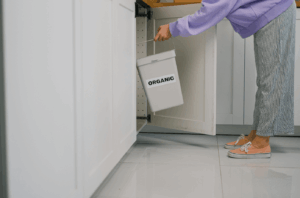Nowadays, it has become easy to store food waste in our daily lives thanks to compost bins (also known as compost buckets) and the compostable bags that often accompany them. These two items play a key role in the success (or failure) of organic waste sorting at home. However, with so many different models, sizes, materials, filters and bags available, it is easy to make a mistake. Too small, too thin, poorly ventilated…
What is the bioseau?
Do you want to compost, or at least sort your organic waste?
The reality is that it all starts in your kitchen, when you have a carrot peel in your hand. And at that moment, either you have a clean, accessible, well-designed container… or you give up. The compost bin – or compost bucket, box, container, whatever you call it – is not a logistical detail. It’s what makes it feasible or not. And that’s often where it gets complicated.
What are the criteria for choosing a good compost bin?
A well-chosen compost bin helps to avoid:
- Odours within two days, especially in summer
- A brownish residue that is impossible to clean (and continues to smell for a long time)
- A lid that you don’t dare open
- A bag that tears when you take it out
- Gnats, because there is no ventilation or too much humidity
What size compost bin should you choose?
Is there a standard size for compost bins?
Most models are advertised as ‘ideal for an average household’. But in reality, your needs are anything but average.
The size of a compost bin depends on just three things:
- How many people live in your home
- How often are you willing to empty it
- How much organic waste do you actually produce (based on your cooking habits)
A poorly sized bin, whether too small or too large, quickly becomes an inconvenience in everyday life.
Which size should you choose for your household?
On average, 1 to 1.5 litres of bio-waste is produced per person per day in a household that cooks regularly. From there, it all depends on how often you empty your bin.
Here are a few useful guidelines:
| Hearth | Desired emptying frequency | Recommended volume |
| 1 personne | Every 2-3 days | 3 to 4 L |
| 2 to 3 people | Every 2 days | 6 to 8 L |
| 4 to 5 people | Everyday | 9 to 12 L |
Tip: If you don’t cook much but have a communal compost bin that is far away or is only collected infrequently, it may be worth getting a slightly larger bin to reduce the number of trips you have to make.
How can you store organic waste for long periods?
A well-designed, slightly ventilated bin that is used correctly can store your organic waste for 2 to 3 days without any problems, even in summer.
A few simple precautions:

- Avoid foods that are too moist or decompose quickly (fish, meat)
- Add kraft paper, cardboard or dry coffee grounds to balance moisture
- Do not compact your waste: a little air = less juice
How to choose the right compost bin?
All organic waste bins promise easy sorting and no odours. But the reality is more nuanced. It’s not a question of price or design, but rather essential criteria that make all the difference in everyday life.
What materials should you choose for an organic waste bin?
- Stainless steel: robust, odourless, easy to clean, but heavier and more expensive
- Recycled plastic: lightweight, economical, moisture-resistant, but can retain odours if poor quality (and beware of microplastics, see more details below)
- Wood or bamboo: attractive, but absorbs moisture, stains easily and can wear quickly
- Enamel or ceramic, or even glass: easy to clean, good at preventing odours, but heavy and fragile
The most important thing is to choose a smooth, non-porous material that does not retain juices or odours. Stainless steel and good-quality plastic are the best options if you are looking for easy maintenance.
Microplastics: an often overlooked risk
Acidic organic waste can damage certain plastic surfaces over time. The main factor contributing to the transfer of microplastics to waste is mechanical wear and tear, such as scratches and abrasion. An intact plastic bin used at room temperature does not pose a major risk. However, a scratched bin or one that has been cleaned with harsh products may release particles into your biowaste, which will not disappear during composting.
Practical tips:
- Always clean with the soft side of the sponge
- Avoid abrasive or acidic products
- Replace worn plastic trays, or opt for stainless steel
Ventilation and airtightness: finding the right balance
Contrary to popular belief, an airtight container traps moisture, promoting fermentation and odours. A slightly ventilated container, ideally with a perforated lid and an activated carbon filter, allows moisture to escape and limits the formation of juices and unpleasant odours.
Exception: if you empty the bin every day or store it in the freezer, airtightness becomes less crucial.
Some high-end models use a partial vacuum system to slow down the fermentation of waste. This system can be useful if you do not empty your bin for several days and have a lot of wet and sensitive waste (fish, meat, very ripe fruit). But in most cases, a well-used ventilated bin is more than enough. Air vacuuming does not compensate for poor sizing or insufficient cleaning. It is an option, not a miracle solution.
Ergonomics and cleaning: keys to success
In terms of ergonomics, we would highlight the practical aspects: a practical bio-bin should:
- Have a lid that is easy to open with one hand
- Have a sturdy handle for carrying without spills
- Be easy to clean, with no hard-to-reach corners or grilles
Regular cleaning with hot water and vinegar (or a dishwasher-safe cleaner) is sufficient to prevent odours.
Why choose biodegradable bags?
In practice, biodegradable bags have a specific and concrete role:
- Facilitates the transfer of organic waste from the bio-bin to the composter or collection point, without splashing or spillage
- Reduces the amount of cleaning required for the compost bin in the kitchen, which increases motivation to sort waste
- Improves hygiene by reducing direct contact with wet waste
However, it is important to note that their effectiveness depends on the quality of the bag and how it is used. A bag that is too thin or poorly chosen may tear when emptied, complicating the entire process. Furthermore, a non-certified bag may pollute the compost or not degrade properly.
Which compostable bags should you choose depending on their use?
The most common compostable bags are made from:
- Corn starch (PLA)
- Cellulose
- Biodegradable plant materials
Bags certified according to European standards offer a better guarantee of compostability. Kraft or reinforced paper bags can be an alternative for less moist waste, but their resistance to moisture remains limited.
Key points: A biodegradable bag that is well suited to the type of waste and the frequency of emptying facilitates high-quality compost. Certified bags, although slightly more expensive, offer better degradation in composting. For home composting, bags that are too thick should be avoided as they slow down the process.
Mistakes to avoid with compostable bags

- Using a bag that is too thin and tears easily when filled with juice or heavy items
- Using a non-certified bag that will not compost properly and will pollute your compost
- Confusing biodegradable with compostable: not all biodegradable bags are compostable under normal conditions
- Underestimating the recurring cost: compostable bags are an expense that needs to be included in your composting budget
Frequently asked questions:
What size compost bin should you choose for your household?
Allow for around 1 to 1.5 litres of organic waste per person per day. Then adjust according to how often you want to empty it: a household of 2 to 3 people emptying every 2 days will need a 6 to 8 litre bin.
Are compostable bags really necessary?
They make transport easier and reduce the amount of cleaning required for the compost bin, but must be chosen carefully to avoid tearing and unpleasant surprises. A certified bag suitable for the type of waste is recommended.
How can I prevent bad smells in a compost bin?
Choose a slightly ventilated bin, avoid compacting the waste, add paper or cardboard to absorb moisture, and empty it regularly. Storing the bin in a cool place or in the refrigerator is also a solution.
Can the plastic in compost bins contaminate organic waste?
High-quality plastic, without scratches or mechanical wear, does not pose a major risk. Avoid abrasive sponges and replace bins that are too worn to limit the migration of microplastics.
What is the vacuum system in some compost bins?
It is a process that reduces the amount of air in the bin to slow down the fermentation of waste and limit odours. This is useful if you do not empty your bin often, but not essential for regular use.

